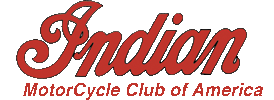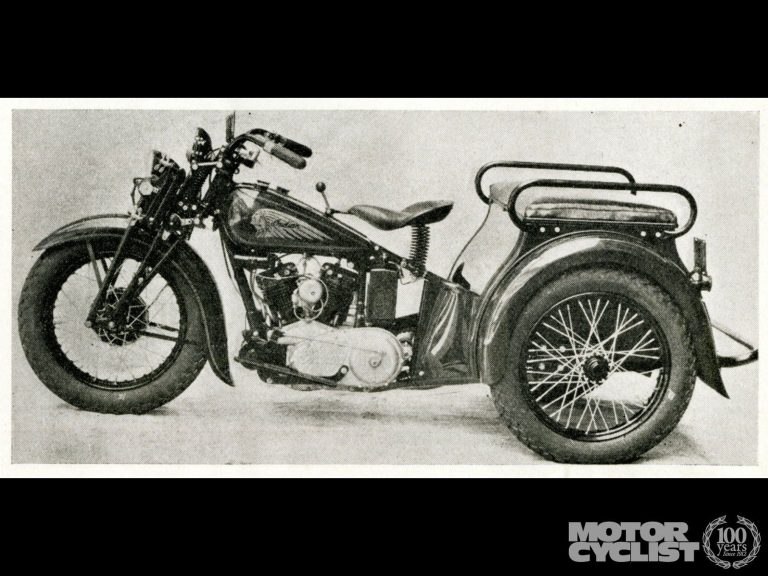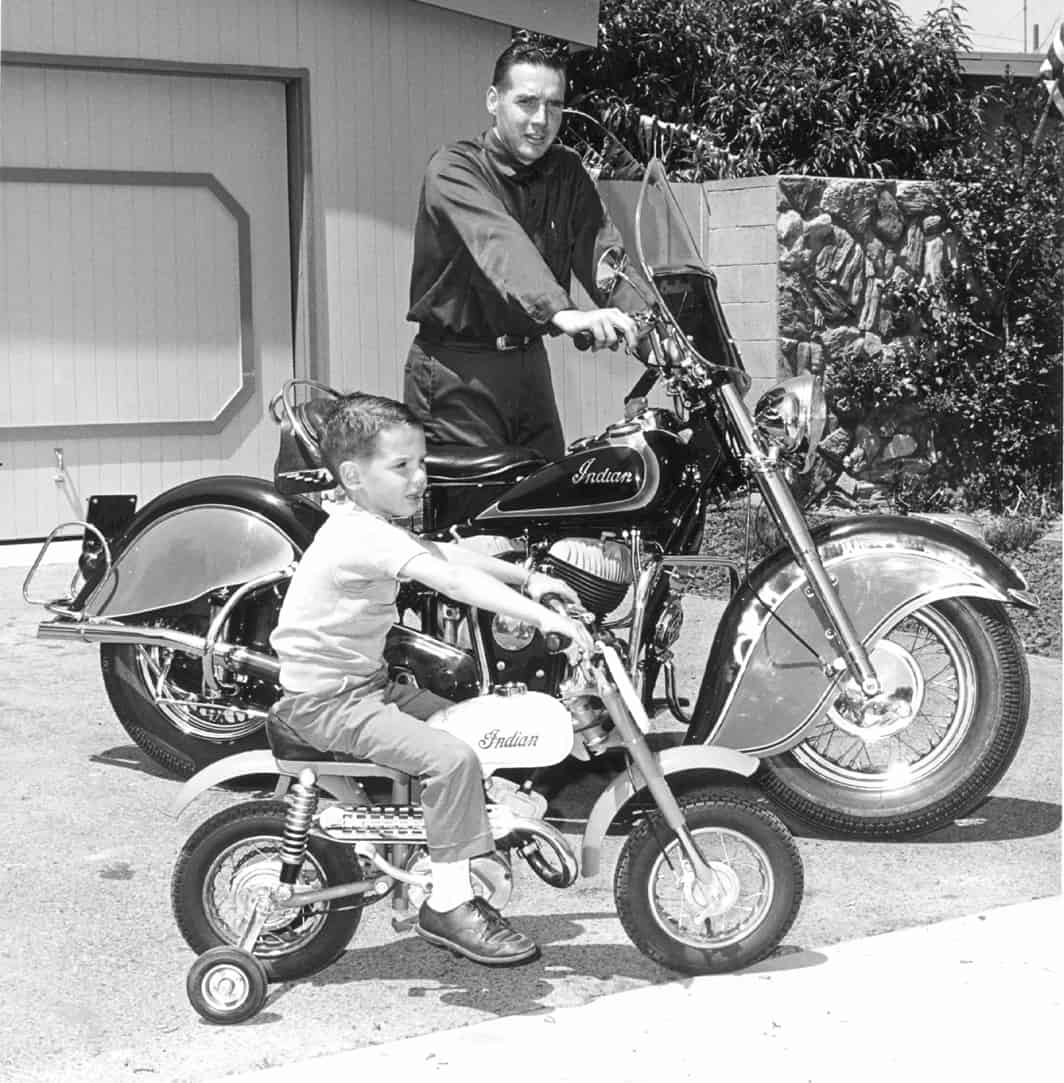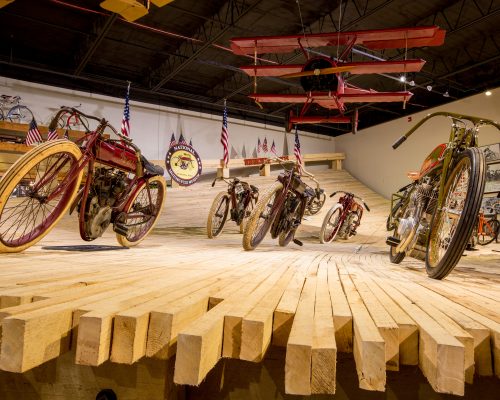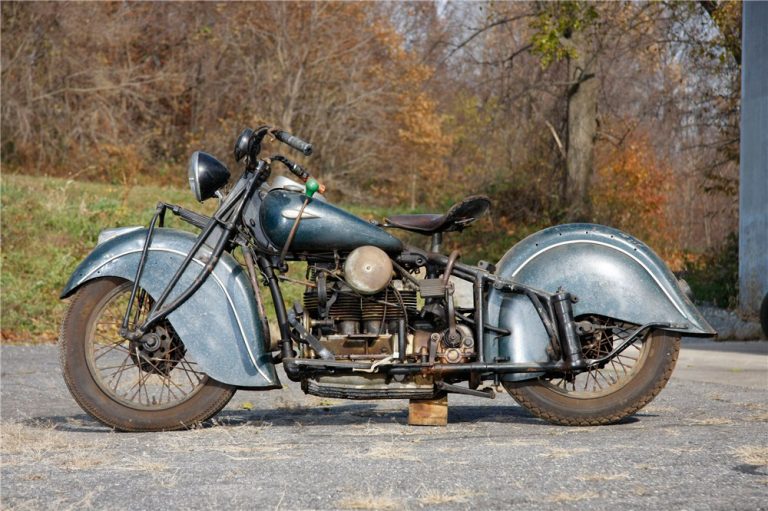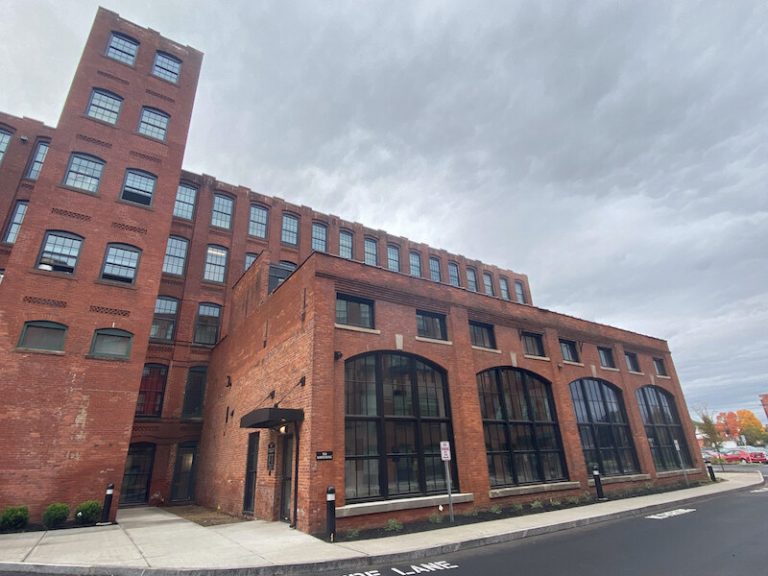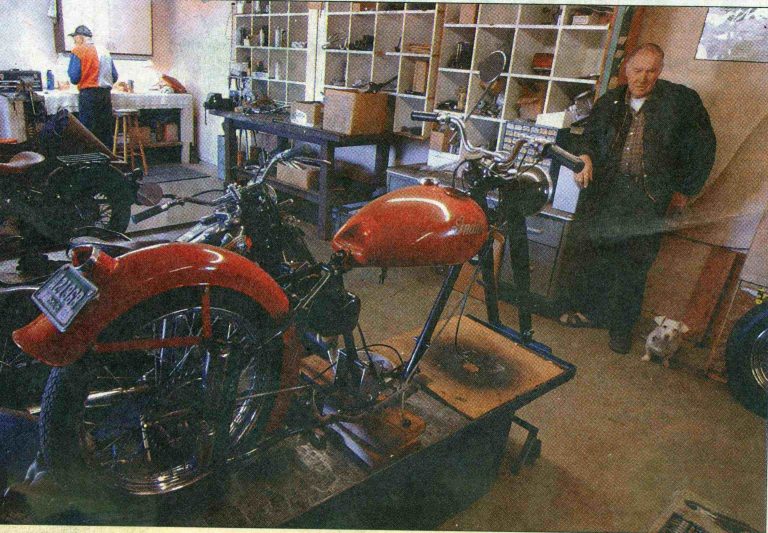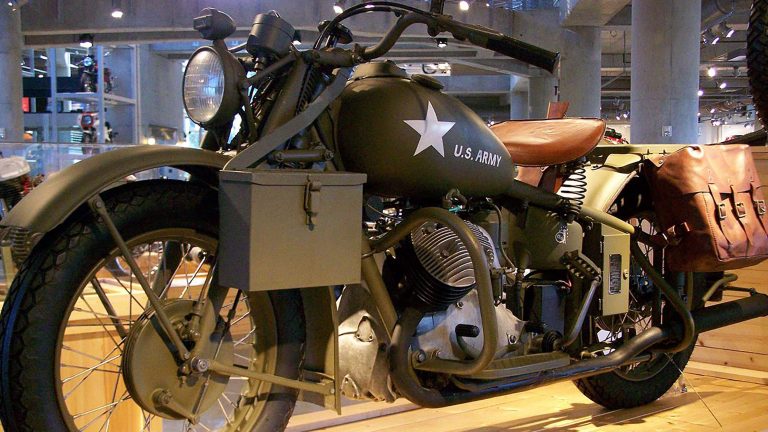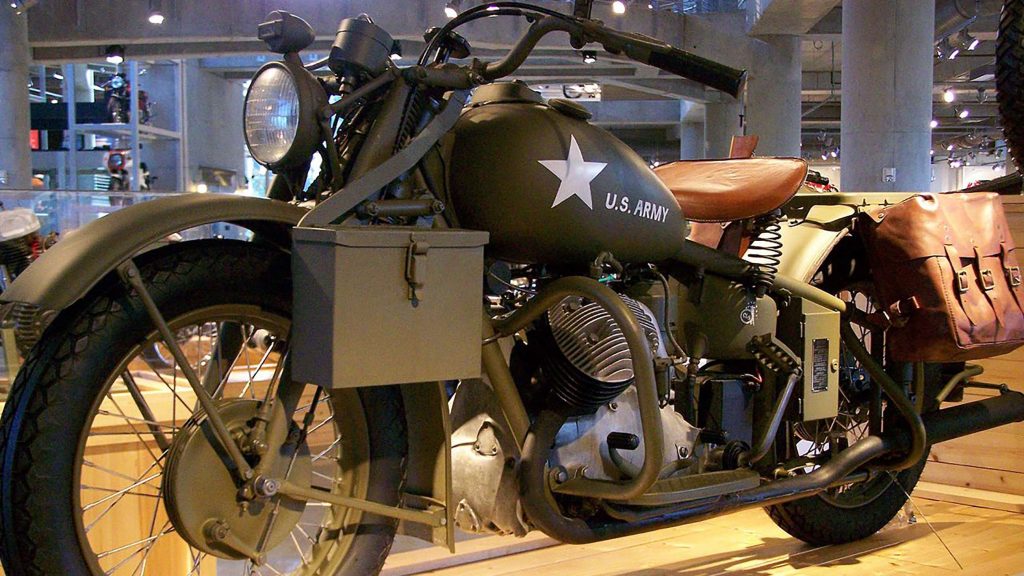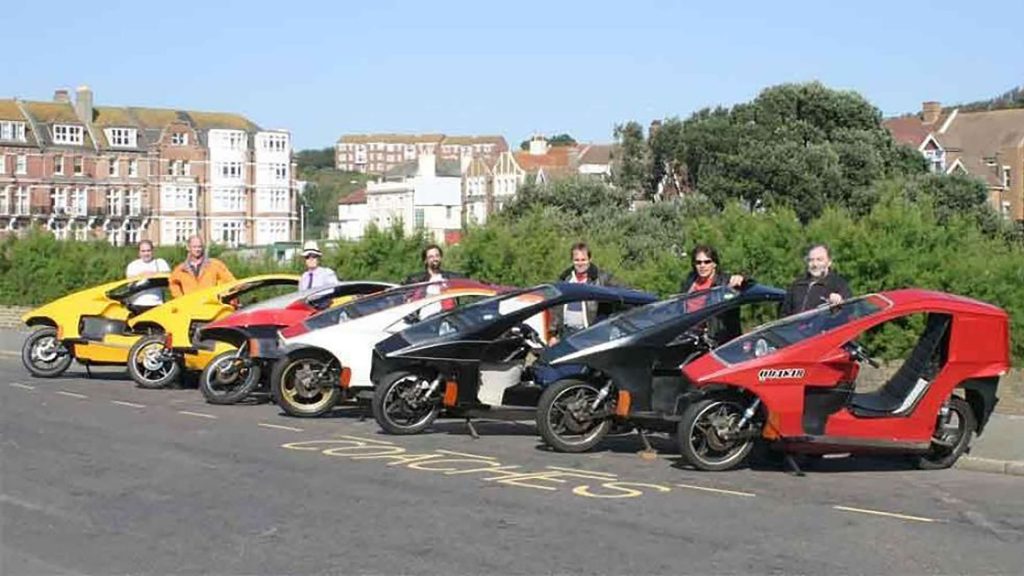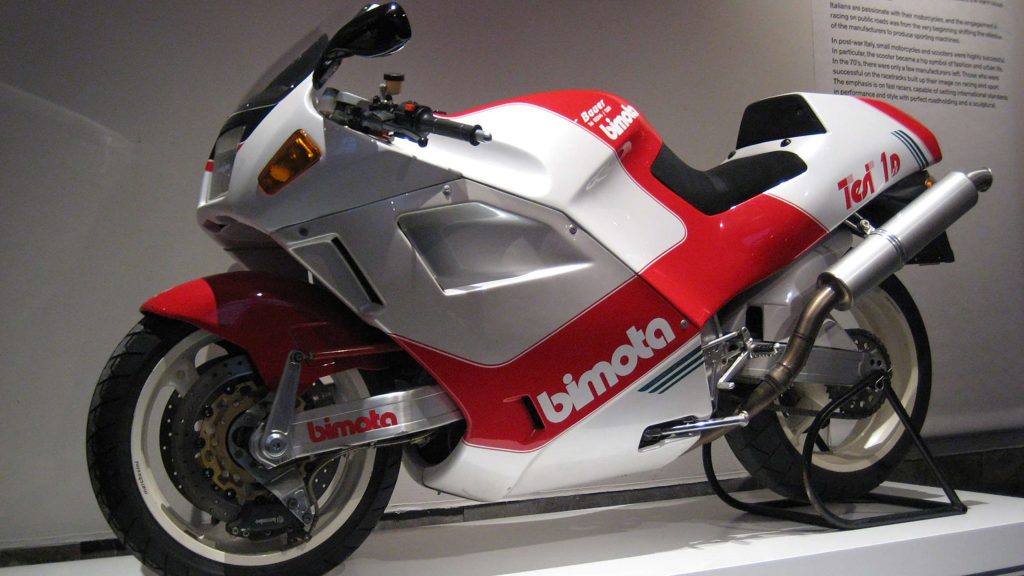The first Indians came to town. The brethren gathered, looked and rode. Then came the verdict, “This year, more than ever before, Indian is going to town.” Along with the rest we tried them out. As usual there was that first interest in balance, dig-out, and lack of vibration.
From the January 1935 issue of Motorcyclist magazine
The first Indians came to town. The brethren gathered, looked and rode. Then came the verdict, “This year, more than ever before, Indian is going to town.” Along with the rest we tried them out. As usual there was that first interest in balance, dig-out, and lack of vibration. Yes, we even uncorked a little of the higher speeds. And, it was at about that point that we went into fourth speed, an optional feature of some of the new models. It was our first experience with a fourth speed forward on a motorcycle. It’s hard to describe the first thrill of that old rush of air and road-all without that feeling the motor is turning over to the point of laboring. It was like speeding up a motion picture; things coming at you, all the sensation of getting somewhere but minus the worry of too many revs. Yes, the new Indians have the appearance of slipping along and handling well. They ride the same way. But let’s get back to the catalog.
To read through the list of features for 1935, with many options in connection with some, is more like scanning a story of motorcycling as we might expect it to be a couple of years from now than as it is actually to be in 1935.
From the set of the handlebars, the sweeping lines of the fenders and the flowing lines of the tanks right down to the chain guard and muffler the attention streamlining has been paid is evident. It has received careful attention on all models.
New colors and new tank designs are another contribution to appearance. There are three-color and two-color combinations. Briefly, the former offers black frame and forks with all of the following: Light blue and yellow, dark blue and silver, dark blue and cream, and Chinese red and silver. In the two-color combinations the frame and forks are of the predominating color, the combinations being as follows:
Blue-dark blue and light blue, green-dark green and light green, red- Indian red and Chinese red, brown-dark brown and cream brown. In both the three-color and two-color combinations the darker color predominates while the lighter is used as trim. One-color standard jobs are still available as follows: Indian red, black, dark blue, silver (black frame and fork), and Chinese red (black frame and fork).
In 1935 all cylinders and heads are to be nickel finished, an item which should be considered in connection with appearance.
The Indian “B” motors are to be standard in all stock models, it being felt that these large motors bring the power and general performance desired by American motorcyclists. A new “Y” motor, built with heavy duty cylinders and special high compression aluminum cylinder heads of aircraft design, is available in the 74 Chief, the 45 Scout and the Sport Scout (only), for those riders who want even more power and speed.
One of the outstanding new offers for ‘35 from the Indian factory is optional tranmission. This means that it is possible to have a 4-speed transmission (four speeds forward) on the 45 Scout and the 74 Chief. Anyone desiring the higher gearing, the means to added miles per hour without increasing the turnover of the motor, can now sate his fancy and at a cost within the means of nearly any cycler.
As a part of the optional transmission offer a three-speed forward and reverse is available for the 45 Scout and the Chief. There is nothing more desirable than a reverse gear on a three-wheel job. It will save its cost in pushing-in nearly any tongue.
Cam ground “T-Slot” pistons are retained in the ‘35 models, their performance thus far having been satisfactory. When the aluminum of the pistons expands faster than the cast iron of the cylinders, due to the not round shape and to the T-Slot, there is a very close fit without danger of “sticking.” Pistons of this design keep in perfect alignment because slap is reduced. In the net a smoother and more perfect running motor is secured.
The principle of dry sump lubrication is retained and various improvements have been added. Regardless of speed or weather Indian dry sump is fully automatic. Exactly the proper amount of lubricating oil is delivered in a constant stream and under positive pressure through the crankshaft to the motor bearings. Then the sump pump withdraws the hot oil from the crankcase, filters it, cools it, and returns it to the tank where it is again ready for another fast trip through the motor.
The multiple row primary chain, running in a bath of oil, remains. It is completely enclosed. This chain drive is quiet in operation and, of course, friction is minimized by the oil bath. The four-row is used on all models except the Sport Scout and on that a three-row is used.
A new streamlined, highly-polished Schebler DeLuxe carburetor with double air screen is a feature of all models. The carburetor bodies are corrosion resisting gun metal finish.
It might be added that the new aluminum cylinder heads are heavier, larger and have new windstream contour fins. The design is one borrowed from aircraft practice. Also from aircraft design are the new tulip valves, a design developed for better cooling efficiency. The valve stems are thicker and so are the guides. The valve springs are heavier. Larger valve dust covers are used and they may be raised without the use of wrenches.
An outside fill type Willard battery designed for accessibility and better cooling is standard equipment.
The rear wheel borrows from the automotive industry, being detachable through six studs and six tapered nuts designed for safety and elimination of wear and play in the rear wheel mounting.
In the muffler a new through valve that has been moved to the rear for greater efficiency is part of a streamline design.
White handlebar grips are standard for 1935 and magneto equipment is still optional.
These are just a few of the considerations in connection with the line-up of Indian models for 193 5. Fundamentally, they are featuring the Scout Pony (30.50 Twin-315 pounds), the Sport Scout (45 cu. in.-436 pounds), the Indian 45, the Indian 74 and the Indian 4. The Pony offers the minimum in weight for a twin. Likewise, its wheelbase is only 52 ½, inches. The Sport Scout is pretty much what the name implies. It has been designed on racing principles for riders who want a light, fast twin. It has a high degree of maneuverability, speed and stamina.
The four is basically the same, an aristocrat, with a variety of options, such as left or right control, battery or magneto ignition and a wide variety of color combinations.
There are two sidecars on the list, the standard and the sport models. The chassis is the same on both models-full elliptic front spring in front and a long semi-elliptic spring in the rear to prevent side sway. The sport model features a back to the seat which hinges and allows access to a roomy luggage compartment. The standard is designed for strength and durability with a body constructed of heavy gauge auto body metal, and seamless steel tubing in the chassis, atomic welded.
Following is a complete list of Indian models, which reads in variety like a page from earlier days when motorcycles were the automobiles of America:
235-B, Scout 45-Battery.
235-BY, Scout 45-Battery, Large Cylinders and Aluminum Heads.
235-M, Scout 45-Magneto.
235-MY, Scout 45-Magneto, Large Cylinders and Aluminum Heads.
Note: Large Cylinders and Aluminum Heads $7.50 Net Extra. Magneto $15.00 Net Extra.
335-B, Chief 74-Battery.
335-BY-Chief 74-Battery, Large Cylinders and Aluminum Heads.
335-M, Chief 74-Magneto.
335-MY, Chief 74-Magneto, Large Cylinders and Aluminum Heads.
Note : Large Cylinders and Aluminum Heads $9.00 Net Extra. Magneto $15.00 Net Extra.
435-B, Indian 4-Battery.
435-M, Indian 4-Magneto.
Note: Magneto $15.00 Net Extra.
535-B, Scout Pony 30:50-Battery.
635-B, Sport Scout 45”-Battery.
635-BY, Sport Scout 45”- Battery, Large Cylinders and Aluminum Heads.
635-M , Sport Scout 45”- Magneto.
635-MY, Sport Scout 45”-Magneto, Large Cylinders and Aluminum Heads
Note: Large Cylinders and Aluminum Heads $7.50 Net Extra. Magneto $15.00 Net Extra.
(Large Cylinders and Aluminum Head “Y” Motors available only on the 235, 335 and 635 Models.)
DT-15, Dispatch Tow with Steel Body, less Tow Bar.
DT-16, Dispatch Tow with Steel Body and Tow Bar.
DT-17, Dispatch Tow with Steel Body, Tow Bar and extra padded seat and hand holds complete.
Bumper, Standard Equipment on All Models.
Special Tow Clamp for Buick or Cadillac, price on application.TC-13, Traffic Car, less Body-with Reverse Gear.
For police use the Indian 74 with 4-speed transmission is likely to stir up a lot of interest. The standard 74 and the four will undoubtedly retain their popularity in some quarters.
In the commercial line-up the Dispatch Tow offers several combinations. Two styles of bodies are available, each with a commodious compartment for tools, accessories, parts, etc. In one style the top is a metal cover, in the other it is an upholstered seat with hand rails, enabling the transport of two additional service men. (Indian has inaugurated a direct-by-mail sales campaign which is designed for dealer cooperation as a follow-up on all commercial car prospects.)
Recognizing the fact that there is a variation in police ratios, the Indian Motorcycle Company has enlarged its commercial line to enable Indian dealers to keep up their full complement of business through the commercial channel. The new feature is the Indian Traffic Car, a three-wheeled job designed to carry loads of one-half ton.
Making a survey of a large number of representative concerns, the Indian Motorcycle Company found that in 17 representative businesses average loads starting out on a delivery route are half a ton. To meet the needs in this field they designed the Traffic Car which provides for a large increase over the side-van type of vehicle, both as to volume and weight. Tractive force is upon both rear wheels, turning to right or left is equally easy. Double braking is afforded and, of course, greater maneuverability in parking than with any automobile. An exceptionally strong frame has been designed with weight being spaced so that the front wheel acts primarily in a steering capacity. The motorcycle frame supports the rider only, this being accomplished by the way the weight is spaced over the rear wheels.
It is practically impossible to overturn the Traffic Car, which gives it a greater safety value than most light automobile delivery vans. In summary, its advantages are the ease of handling in congested areas, ease of parking, speeding up delivery, safety in traffic or hilly country, and economy per pound per mile delivery. It also presents a range of advertising possibilities. Its disadvantages are possibly a feeling on the driver’s part of not being so comfortable as in the closed-in cab motorcar.
This year more than ever before it seems that the total registrations of motorcycles should increase. Many there are who follow motorcycling as a sport because they enjoy watching the capers of all the boys from our national champions down to the newest club recruit. They are under the impression that to ride a motorcycle one must be an athlete. Such is not the case. Light motorcycles, capable of every requirement for economical and safe transportation, are available to anyone in 1935. Thousands of Americans would be ahead in pleasure and money if they took to two wheels instead of four. That more of them have not is undoubtedly due to the fact that they have never been given the opportunity to ride. It is hard to believe that if these individuals had the chance to feel the power and find out for themselves the ease of handling of the ‘35 models they would not be captivated to the point of purchase.
We are prone to emphasize here, as we did elsewhere in this issue, the importance of dealers carrying an ample stock of 1935 models. During the past couple of lean years inventories have been sadly depleted. Because the situation was general, it being the practice in other lines than motorcycles to order from catalogs or literature results were not so serious as they are likely to be this year. Now the trend is back toward larger stocks.
The last couple of years when a rider dropped in to look over motorcycles the chances were about even up that he was only window shopping anyhow. He was out of work. He wanted a new motor but it just wasn’t in the cards. By actual canvass it has recently been determined that unemployment is less among motorcyclists than in many other groups. When a rider comes in today, he still may be window shopping but he is much more in a position to deal if he should become interested. Once a motorcyclist becomes interested he means business, too. One dealer may sell the rider on the idea of a new Sport Scout or a new Chief but another dealer may be the one to make the delivery. The answer needs no explanation. The boys are going to deal where they can pick out the job they want and then get immediate delivery on what they pick out.
In line with the above there is one more thought for dealers. Women are turning more and more to actual riding. Within the last year the number of ladies auxiliaries has increased from two to twenty-two. There are that many registered with the A.M.A. With that as a token of encouragement and with the new light weight machines as a medium for the furtherance of this interest it is reasonable to suppose that before the time ‘36 models are announced there should be a couple of times twenty-two auxiliaries. It has been said that when women take up motorcycling in America then the sport will really go to town. So, how about it-ladies, riders in general and dealers?
New Features
Streamlines: Completely streamlined are all 1935 INDIAN Models; the sweeping lines of the fenders, the flowing grace of the tanks, the set of the handlebars, and even to such details as the muffler and chain guard.
Improved Motors: The famous INDIAN “B” motors are now standard in all stock models. These big motors bring greater power, more speed and finer performance to the 1935 INDIAN motorcyclist.
Then, too, the big new “Y” series special motors are available in the 74 cu. in. Chief, 45 cu. in. Scout and the Sport Scout (only), for those motorcyclists that want even more power and speed. These “Y” motors are built with extra heavy duty cylinders and special high compression aluminum cylinder heads. ($9.00 Net Extra on 74” Chief-$7.50 Net Extra on the Standard 45 cu. in. Scout and the Sport Scout.)
Four-Speed Transmission: In addition to the standard three-speed transmission, INDIAN offers for 1935 a four-speed transmission as an optional feature. Four forward speeds, a simple efficient rugged unit-that provides for that higher gearing when desired. $12.00 List Extra.
A three-speed and reverse transmission is also offered as an optional feature and is especially advantageous for commercial and sidecar units. $15.00 List Extra.
(These options available on 45 Scout and 74 Chief only.)
New Colors and Tank Designs.
Dry Sump Lubrication-Better than ever for 1935.
Multiple Row Primary Chain Drive- Running in constant bath of oil.
New Streamlined Carburetors-Highly polished Schebler DeLuxe with double air screen.
Cam Ground “ T-Slot” Pistons-Which insure improved motor performance and quiet long life for both piston and cylinder.
New Aluminum Cylinder Heads- Heavier, larger, with new windstream contour cylinder head fins.
New Roller Bearing Retainers- Of new tough durable alloy, which reduces the weight of the connecting rod roller bearings 50%, thus, lessening strain.
New Aircraft Type Tulip Valves- Providing better cooling.
Larger, Thicker valve Stems and Guides.
Larger, Heavier valve Springs.
New Larger valve Dust Covers-Requiring no wrenches to raise covers.
New Outside Fill Type Willard Battery -Providing for perfect air cooling and accessibility.
Cylinders and Heads- on all 1935 INDIANS are nickel finished.
New Detachable Rear Wheel-Automotive Type-with six studs and six tapered nuts, providing the utmost in safety, yet eliminating wear and play in the rear wheel mounting.
New Mufflers- With streamline design and a new through valve that has been moved to the rear for greater efficiency.
New White Handlebar Grips- are standard for 1935.
Source: “Modern To The Minute” 1935 Indian Motorcycles
